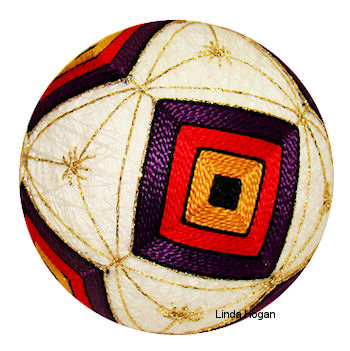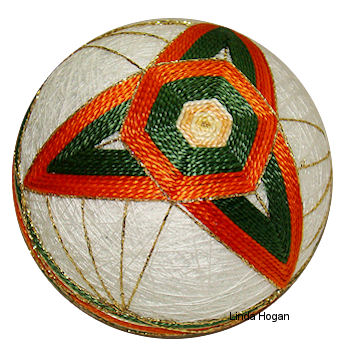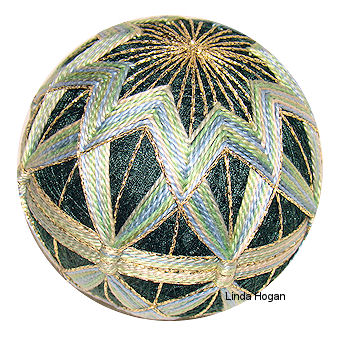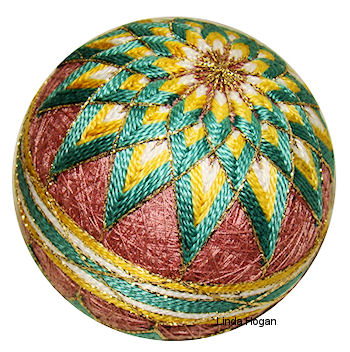Certification by the Japan Temari Association
Traditional Temari crafting is preserved & advanced by the Japan Temari Association, which functions as the certifying school/association for temari. Membership in the JTA offers the opportunity to evaluate one's skills via four levels of certification examinations. Participation in the JTA is offered through Ai M., Shibu-cho and head of the JTA Chidori Temari Group which was formed by the JTA to manage international JTA members (be sure to also read the information on her TenTemari site). There are no deep dark secrets about the JTA; everyone is encouraged to learn about it and certification, whether you wish to take part or not. You'll understand more about the art in general, and about the standards being looked for. To learn about and stay informed about JTA info, whether you aspire to certification, would like to see examples of exam submissions and submission guidelines for the levels, or are just interested in the process, join the JTAMentor&Study group on Yahoo Groups.
Why certify?: It helps to first understand the place of certification in Japanese culture. Throughout history, most all schools/associations of fine, performing or martial arts in Japan have and do include certification exams as a standard part of their curricula. It is an integral part of the learning process both for hobbyists as well as professionals (avocations are as important as professions in Japan; everyone engages in something with few exceptions, and lessons are approached very seriously). Certification is not a competition; rather, it is a method by which one's skills are evaluated by masters of the art, against a given set of performance standards, and marks as student's progress in learning. Certification is also used to qualify teachers, providing a method by which students know they are learning from a reliable source as well as insuring that traditional standards are maintained. The Japanese approach to hobby/avocation learning is much different compared to the West, and prompts the question of why a temari student outside of Japan would wish to take certification exams.
Whatever skill that you set out to learn and explore, it should be because you want to expand & extend your horizons, stretch your skills & talents, and enjoy - not because you "want to certify". When I mentor and teach, there is no separation between those that wish to certify or don't - everyone is taught the same things, with the same diligence, at their own pace. There is not a separate lesson plan or "JTA course" from someone taking exams versus those who are not; no information or skills are withheld from someone not interested in certifying. If a student chooses to take the exams when eligible, fine - they are prepared. If not, that's just fine too. The one and primary goal is to learn & enjoy the art of temari, not gain a certificate. It's a personal decision and different for each person.
For those choosing to join the JTA, it's usually about looking for a deeper cultural connection to the art, about evaluating your skills against a given set of long-held standards by JTA masters, delving a bit deeper in how stitches work and come together to produce designs, and participating in pattern creation and documentation. Some people work & learn better with defined challenges (levels) to work towards as goals. Others enjoy the feeling of coming closer to the historical aspects of the art, and to an extent, Japanese custom. For many, it is about becoming a part of and supporting the school that is dedicated to carrying on the traditions and knowledge of the art of Temari, so that it can be enjoyed and advanced in modern times. However, it's not about bragging rights, hanging a certificate on the wall, or thinking that it makes someone better than others who opt not to join the JTA. Many, many very good & talented temari crafters happily learn and stitch without engaging in the JTA.
General Membership Information: Membership in the JTA is required to be eligible for certification (see details below). There is a one-time entrance/application fee, as well as an annual membership fee. The JTA functions on the fiscal year of April 1 through March 31 (as do all aspects of Japanese business and education). All dues (new and renewing) are required to be paid in March for the upcoming membership year that begins on April 1. New members will be given the required help and information from their teachers beginning in late February. Renewing members will be notified by your teacher when the JTA is accepting dues payments but it is the member's responsibility to follow through. Membership must be maintained each year unless a withdrawal has been requested. A member may be allowed to temporarily withdraw on a yearly basis; written notice must be provided to the JTA. The time spent in withdrawal does not count towards study time between exams (for example, if a Koutouka student withdraws for one year, then they must study for an additional 2 years after the one year withdrawal before being recommended for Shihan exam for a total of 3 years after passing Koutouka). New & renewing members submit payment to the JTA via PayPal (new members will be aided by their sponsoring teacher) during March of each year.
General Certification Information: The JTA has been very gracious in welcoming international members via the web since 2005. It has been proactive in adjusting to and supporting the needs of students and teachers working outside of Japan, both to facilitate the opportunity and to maintain JTA standards. Learning can be via in-person classes, online, or independent study, but the online/international requirements are identical to the in-person process used in Japan. A person wishing to begin certification (details below) must be recommended by a JTA teacher (Shihan, Kyoujyu &/or Shibu-cho level). The deadline for submitting application materials to the JTA is May 31; judging occurs during June and finalized at the annual meeting of the JTA (usually the last Sunday in June). Applicants are both notified shortly thereafter as to whether they passed, and will be delivered of their certificates in later July or August through their recommending teacher. Note that application work must be completed well ahead of the May 31 deadline in order for it to be processed & translated to be in the hands of the JTA by the May 31 deadline. The present day JTA requirements incorporate relaxed elements of the traditional apprentice system (which historically could take upwards of 60+ years to attain master level) in terms of mandatory study and practice periods. While condensed into a more modern time frame, it reflects the standards that apprentices were held to (often regardless of talent) before becoming practitioners - let alone masters - of their arts. It helped then and helps now to insure that students are dedicated to the art, respect its history and traditions, and respect its masters (past and present). Thus, the four levels of certification add up to 6-8 years (generally more) of study with at least 100 temari designs having been made. Only Shihan and Kyoujyu JTA members are qualified and entitled to teach. To present a parallel, minus a defined certification process, this would mean that before someone considers themselves good enough to offer temari classes or lessons at any level, one should have been studying and practicing temari at least three to four years & completed at least 80 different temari (from simple to complex designs) before considering oneself accomplished enough to teach.
JTA policy also includes that a teacher cannot recommend students for exam levels equal to or higher than what current rank that teacher holds. A student wishing to study for Shihan must be working with a Kyoujyu or Shibu-cho (supervising Kyoujyu), or jointly with a Shihan and Kyoujyu or Shibu-cho. A student wishing to study for Kyoujyu examination must study with a Shibu-cho, or jointly with a Kyoujyu and Shibu-cho. In all cases, it is the highest ranking teacher that submits the student's work to the JTA for examination. Effective 2016, international students at all levels much show proficiency in a JTA-approved curriculum that is equal to that of taking classes in Japan, to insure consistent standards and eliminate any confusion. As a JTA Kyoujyu, I am thankful to have the opportunity to be able to work with students wishing to apply for all levels through Shihan; Ai has agreed to serve as our Shibu-cho for those wishing to apply for Kyoujyu.
Certification Levels:
Honka Shuuryou / Basic Course (Level 1) : A student applying for this level of certification has generally been studying temari for at least 1-2 years, and completed at least 20-30 temari. This level of certification test skills in making & preparing mari, simple divisions, basic stitching technique and basic stitch patterns. These include chidori kagari, matsuba kagari, shikaku, tsumu, uwagake chidori kagari, mitsubane kikkou, jyouge douji kagari, hoshi, nejiri kagari, & kousa kagari. A student should have completed at least 2-3 temari using each skill. The following samples, via digital photo, must be submitted for examination: One Simple 4 Division Temari, stitched in Shikaku (Masu Kagari); One Simple 6 Division stitched in Hexagon and Tri-Wing (Mitsubane Kikkou); One Simple 8 Division stitched in a concurrent North-South Pole pattern (Jyouge Douji); One Simple 12 Division stitched in Uwagake Chidori, Kiku Design, with obi. Temari should be 25 +/- 2 cm in size. Stitching threads should be pearl cotton #5 equivalent or thinner; it may not be thicker than Pearl # 3. Photos are submitted rather than actual temari. A worksheet to assist in preparing for this exam can be downloaded here.
 |
 |
 |
 |
| Masu Kagari | Mitsubane
Kikkou |
Jyouge
Douji |
Uwagake
Chidori |
Koutouka Shuuryou / Higher Course (Level 2): A Koutouka student will completed at least an additional 1-2 years of study since attaining Honka, and crafted 40-50 different temari in addition to having mastered all of the basic stitching skills in addition to pattern writing skills. Building upon the skills learned in Honka, these also include: 8 Tobun; 10 Tobun; Shitagake chidori kagari; Yubinuki design; Uwagake chidori kagari; Maki kagari; Renzoku kagari; Nejiri kagari; Kousa kagari; Asano ha kagari; Bara; Kagome; Hoshi; & Hitohudegake. One must submit pattern instructions that includes completed photo, stitching diagrams and verbal instructions for 3 8-Combination temari patterns and 3 10-Combination temari patterns. These not need be nor should be original/creative patterns; they should be interpreted from other sources but use your own newly-done diagrams, verbal notes and photos of finished temari (not verbatim, digitally or mechanically copied from the sources used) in order to show that a pattern can be understood and communicated to others. A student will also be able to demonstrate an understanding of design composition as well as executing, stitching and symmetry on Combination Divisions. There is no size requirement or restriction but 25-40cm is encouraged. Stitching threads should be pearl cotton #5 equivalent or thinner. A worksheet to assist in preparing for this exam can be downloaded here.
Shihanka Nintei / Teacher Course (Level 3): requires at least 2 years of study after completing Koutouka, as well as being considered worthy, based on exhibited experience/skill and overall number of temari made in study lifetime (usually 80-100 different designs). The student must be recommended by a Kyoujyu or Shibu-cho. Additional skills required include: Tamentai/Polyhedrons from C10 (constructed by pentagon and hexagon); Basic additional markings on 8 toubun no kumiawase and 10 toubun no kumiawase; Advanced stitching techniques such as sujidate kagari, renzoku kagari, uzu, sakasa uwagake chidori kagari; understanding of making all-over (completely stitch-covered) temari by kousa kagari. One must submit 8 original composition temari (3 temari must be sent to JTA, not photos) along with diagrams and verbal instructions for all 8. All must be of excellent quality, and show a wide repertoire of skills. There is no size requirement or restriction, but 25-40cm is encouraged. Stitching threads should be pearl cotton #5 equivalent or thinner. A wide range of the basic skills should be shown but in designs more advanced than Koutouka; they cannot be interpreted from books or other sources. Design instructions should be written using relational measurements. Submitted designs should include a tamentai design, and also one using shishuu/free embroidery. In addition to the required designs, once must also submit to their teacher (not the JTA), photos of temari using required advanced techniques. The major thrust of this level of examination is to test depth of knowledge of the student's collective skills: understanding of verbal terminology, ability to clearly communicate techniques to others, and a deep grasp and respect of the traditional techniques of temari, combined with the ability to use them in creating temari. This level is obviously a most rigorous test, for clear reasons - this is one's "teaching license". In Japan, Shihan certification must be attained before one is entitled to teach.
Kyoujyu Nintei / Master Course (Level 4): requires at least 3 additional years of study after attaining Shihan certification. The student must be recommended by a Shibu-cho. One must submit 6 original design temari, including the actual temari, photos, diagrams and verbal instructions.There is no size requirement or restriction but 25-40cm is recommended; any threads may be used. A higher degree of originality is required than Level 3 Shihan; all temari must be of excellent quality and advanced skill. Skills should include variations of polyhedras (triangles, squares, pentagons, and hexagons mostly) made on the 8 toubun no kumiawase and 10 toubun no kumiawase; Complicated renzoku kagari; Complicated hitohudegake. In addition to the required designs, a student must submit to their teacher photos of temari using required advanced techniques.
For those aspiring to Level 3 and 4, as noted, some of all of the actual temari and all supporting documents are sent to Japan for examination judging. Normally, these temari are retained and used by the JTA at their discretion for purposes as they see fit such as (but not limited to) exhibition in the Japan Temari Association Museum displays in Tokyo (which are rotated weekly), inclusion in traveling exhibitions that the JTA provides to/for various locations & purposes, possible inclusion in future JTA publications, assisting in teaching, and also to be sold in the JTA Museum Shop for the benefit & support of the JTA. When temari that have been used by the JTA for these purposes are sold, they are acknowledged in the JTA Newsletter. Beginning with the 2015 exams, in lieu of the temari remaining with the JTA, a student may request the temari be returned to the student. However, the applicant must cover all costs involved including postage to Ai from the JTA, postage from Ai to the student, and a handling fee of 1000¥ ($10US).
============================================================
International Applicants to the JTA: Beginning in 2006 it became possible for Temarikai readers outside of Japan to join the JTA and apply for certification through Ai M., JTA Kyoujyu/Master & Shibo-cho. Ai first mentored two people for certification via electronic materials in May of 2005. Since then over 60 people attained certification through the combined efforts of TemariKai and Ai's mentoring. In order to help manage and communicate with international members, the JTA voted at the 2011 Annual Meeting to create a branch chapter for the people that join/apply to the JTA through Ai; the chapter name is Chidori Temari Group. All those that become JTA members through Ai and the Shihan & Kyoujyu that have certified through her are members of this chapter; there is no additional charge to be in the group. Upon my completing Kyoujyu in 2010, Ai and I began working together for helping students prepare for examinations.
Those wishing to join the JTA may do so by working with me as your Kyoujyu and Ai as our Shibu-cho. Beginning with the 2016 exams, full translation into Japanese of write-ups will no longer be required (as in previous years) for international applicants. The student's Shihan or Kyoujyu will take primary responsibility for reviewing text that accompanies photo and diagrams. Upon acceptance by the student's sensei, their work will be forwarded to Ai for review. If acceptable, then Ai will submit the application materials to the JTA. The final evaluation by the JTA jury will be based on photo, diagram and actual temari depending on level, along with the recommendation of the student's sensei and Ai as Shibucho.
The Call for Applicants is announced each year through Temarikai News and the TalkTemari & JTA Mentor Yahoo Groups, generally late fall or early winter for the upcoming June exams. You may also email a request or inquiries to me. Please note and understand: the May 31 deadline is when all materials must be delivered to the JTA; submission of your application work (that means your work sent to me, corrected as needed, and all the files finalized) generally needs to be completed by April to early May in order for it to be gotten to Ai and then the JTA in time for exams. That means prep work occurs January-March, so please plan accordingly. While overall preparation is based on a student's individual study of temari by any of the available resources, exam mentoring is working together one-on-one to prepare the student's work for submission to the JTA. This can include but is not limited to a review of a student's desires & goals, critique & tutoring of stitching work for eligibility, critique & tutoring of written materials where required, digitizing files if needed, working with Ai as needed, and assistance in the digital packaging your materials for submission to the JTA. For first year/new members, it also includes helping to submit your membership application. Also to note is that even though the JTA sets down minimum study and experience requirements, eligibility for exams is at the discretion of your mentoring/sponsoring teacher(s) based on level being applied for, and is evaluated for each individual.
Application materials for Honka and Koutouka levels are submitted via .jpg and .doc files. Final work will be converted to PDF files. Shihan and Kyoujyu require some or all of the actual temari to be sent to Japan. In addition to the JTA fees, review and expense fees are added by Ai her services. Expense fees include: translating/processing your membership application or annual renewal, postage for membership and certificate materials, review of exam submissions, mailing/postage fees within Japan to the JTA, and PayPal fees. I do not add teaching/mentoring charges for helping students to prepare for exams; it is Japanese tradition that schools provide their teachers with a recommendation/appreciation fee (a portion of the exam fee) for submitting successful applicants. In the JTA's case, this is 50%, which for me is adequate in gratitude for all that I have learned and enjoyed from the JTA (the years that I spent working on certification levels were wonderful & enlightening; I learned much, even beyond the skills of temari). I do add a cover charge for expenses (such as but not limited to printing, postage, PayPal fees, and threads (in many cases I stitch parts or all of writeups as part of evaluating them) of $25 per student per level. As we work diligently together as a team, hopefully for many years, I will be helping you to review, expand and fine-tune your work which can entail supplies, and I will also mail your certificate(s) to you as you pass exams.
| JTA
Application and Exam Fees Summary (subject to current
exchange rates) |
|||||
| Honka/New (¥) | Honka/Renewing (¥) | Koutouka
(¥) |
Shihan
(¥) |
Kyoujyu
(¥) |
|
| Application Fee | 2000 | ---- | ---- | ---- | ---- |
| Annual Membership | 3000 | 3000 | 3000 | 3000 | 5000 |
| PayPal Fee |
245 | 163 | 163 | 163 | 245 |
| Membership Total (*Estimate) |
5245 / $52.45US | 3245 / $31.63 | 3163 / $31.63US | 3163 / $31.63US | 5245 / $52.45US |
| Membership
fees are remitted directly to the JTA via PayPal. You will
receive membership card and JTA News via email. General
reminders will be sent via Temarikai News & the JTA Mentor
and TalkTemari discussion lists, but the JTA does not send
personal reminders or invoices. Maintaining membership
and paying dues on time is each member's responsibility. While
we endeavor to post general reminders when JTA renewals are
due in March, we accept no responsibility for any person's
failure to maintain membership in good standing. |
|||||
| Honka |
Koutouka |
Shihan |
Kyoujyu |
||
| Exam Fee | 4000 | 6000 | 20,000** | 40,000** | |
| Ai's Fee/Exam | 700 | 1500 | 2200 | 5300 | |
| Prep Aid (Ginny T.) |
2000 | 2000 | 2500 | 2500 | |
| Exam Total (*Estimate) |
6700¥ / $67US | 9500¥ /$95US | 24,700¥ / $247US | 47,800¥ / $478US*** | |
| (*subject to exchange fees at time of payment; usually ~100¥ / $1.00US). For students applying for Honka and Koutouka together in the same year, Ai's fee is 2000¥. ** For Shihan & Kyoujyu exams, 3000¥ and 6000¥ respectively are charged at time of application for exam; balance is due upon successful completion of exam. ***Newly passed Kyoujyu must also increase their membership fee to that rank; you will be billed for 2000¥ plus 123¥ (PayPal fee) at that time. Fees effective December 2015; remittance of all fees are final. With the exceptions noted on Shihan and Kyoujyu levels for partial fee payment, there is no refund or cancellation of JTA fees if the judging standards are not passed. | |||||
While all effort and good intention is offered by everyone, payment for fees, services and expenses is final & does not constitute guarantee of acceptance in judging by the JTA. You understand and accept that application is your responsibility, and there is no refund if you do not pass license judging with the JTA.
Any changes and updates in processing arrangements and costs will be specified on TemariKai each year, and announced through JTA Mentor and TemariKai News, so that those wishing to apply in the following spring will have sufficient notice and be able to start the process. Remember that work for certification should be an on-going process, and not "stitched for the exam" at the time the call for applicants is offered. Ideally, your application materials come from your completed portfolio of work, not as a separate effort. Please also remember that the deadline for submission to me/Ai will be considerably earlier than the May JTA deadline, so that we have sufficient time to work with you on your application package and translations. As more and more people begin and continue the process, it is evolving into a more year-long schedule to allow for mentoring students and allowing Ai sufficient time to complete things on her end. Notice will be sent out each year via TemariKai News and JTA Mentor when applications are being accepted; you may also email inquiries at any time.
With
thanks to Ai and the JTA
This
is a TemariKai.com Printable Page; © 2017, all rights reserved.
Right click to print one copy for personal use.
Last updated 4/2017 © 1998 - 2017 TemariKai.com, G. Thompson/PuffinStuff, Inc.
